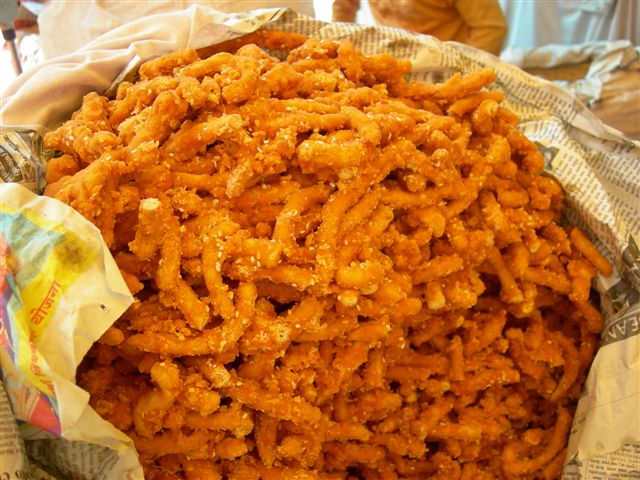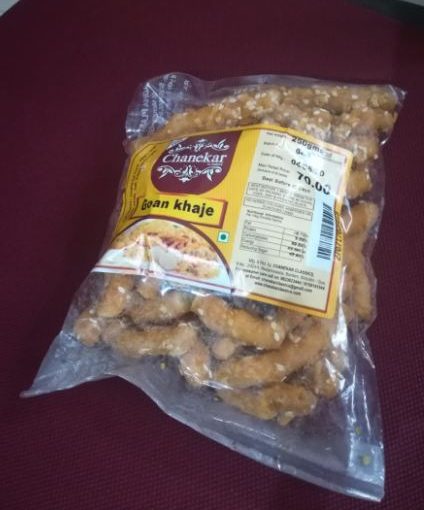The Chanekar khaje is available at Magson’s along with other treats: Comes in plastic wrap and is priced at `70 now. Khaje or khaze is one of country Goa’s all time favorite monsoon time zatra treat – now available all year round. Nutritious because it is made of special gram flour, coated with ginger-flavored jaggery and flecked with sesame seeds, you get protein, iron, calcium, mineral values and loads of calories too — but don’t feast out on an entire packet like I can sometimes! I only hope my khaje is not deep fried in palmolein or one of the hydrogenated veggie fats.
By Tara Narayan
CAN’T think of any other sweet something more deserving of a GI or geographical index than kadio bodio or khaje! News comes that the all-Goan Hindu zatra or Catholic festa sweet of khaje (or khaze) has been crowned with the GI crown and I’m happy. Some sweet something never loses its charm but remains evergreen in our conscience singing a song of joy on the palate forever and one such sweet is Goa’s khaje or khaze or kadio bodio.
Ninety-nine percent of sweetmeats lose their charm except for the occasional temptation of a badam, pista or elaichi studded besan ladoo or barfi. But for me one sweet will never lose temptation and that is my favorite Goan sweet, the quintessential zatra sweet khaje, or khaze more sophistically …khaje I suppose has such a soft tempting, captivating sound, a whisper of a word which makes one’s ears perk up with anticipation. Khaje sounds so captivating, a word conjuring up magical moments. This is to say I looove khaze.
You will see hillocks of khaze at most Goan festivals and much of it may be corrupted with colored sugar or maida, and of indifferent quality – but if you find one of asli quality, buy it quick like I do! These jaggery encrusted crunchy squiggles dotted with a generous scatting of white sesame seeds is very popular with Goans young and not so old, and for all those whose hearts pine for the Goa of their youth – like mine does sometimes, very often, as I watch that Goa varnishing year by year.
I hope khaje is around much after I’m gone with the wind! I cannot for the life of me in my life of many refusals, too many refusals, refuse a piece of khaje be it post-breakfast, lunch, or for no reason at all except that it’s a timeless hungry moment when all I want to do is to reach out for that crooked matt gold crunchy sweet of khaje to look and marvel at first before sinking one’s teeth into it with attendant delights to follow which may reduce one to unimaginable satisfaction.
Khaje, my dears, is one sweet which retains its integrity of being nutritiously desirably, that is if you know where to get the asli khaje of course. I wonder who invented the Goan khaje and what its history is steeped as it must be in the mists of time. I hear that it is Minister of Waste Management, Science and Technology, Port and Rural Development of Goa Michael Lobo who is behind this idea of making Goan creativity nationally and globally famous – and so khaje was recently registered as Made in Goa or Product of Goa on India’s GI register.
Goa’s cashew feni of course has long since been GI registered courtesy the efforts of Mac Vaz & Bros – and now we have Goa’s timeless country mela sweet or the timeless khaje or kadio badio enjoying GI fame and name! Hurrah to that. A few other things quintessentially and traditionally Goan may now queue up for GI status too and some may be deserving or not deserving depending on what the criteria is
As far as khaje is concerned in my mind at least it qualifies. Long ago at a zatra in Goa I’d discovered the khaje of Rajaram Chanekar of Bicholim and after that if I see a packet of this khaje I buy it. Most times it’s available at Magson’s which stocks the Chanekar range of savories and sweets; although one of this days I must go see how khaje is made in Bicholim, it’s a long standing wish but if wishes were horses and all that…okay, I’m happy I get my khaje in Panaji when I want it.
In my opinion a good crunchy golden piece of khaje would be golden soft with jaggery without (no grit please), firm to the bite within without being hard within, and the exquisite flavor of ginger and a generous scattering of sesame seeds atop it coming through. I look for sesame seed khaje crumble at the bottom of my packet and stir it in milk of choice to savor, or use it up somehow for pleasant flavors — add it to your home-made bhakri or chappati or paratha dough if you like. (Sigh) Am I imagining it or is the sesame seed quote becoming smaller and smaller? Why is it that so often when the price of anything goes up, its value of money goes down. Hope with the GI khaje won’t become more expensive! I used to buy at 40, then50 and currently it is `70.
Oh yes, I would serve the best khaje at any party. Only khaje, nothing else. One of Goa’s most loved scientists Nandekumar M Kamat says there must be at least 300 things so quintessentially Goan that they merit GI registration. Okay, compile the list…cashew feni, Khola and Harmal chilllies, Moira bananas and khaje are already GI, but perhaps one could add on Goa’s salt water pickled green mango called chepnim, also may be Goa’s special breed of seven-ridged okra or ladies finger called “saathsheera” — which reportedly grows up to a foot but retains tenderness (doesn’t become fibrous), most expensive organically cultivated okra/bhendo/ladies finger though!
May I also include the recipes of khatkhate, ambadeche sasav, moogache ghati, but with recipes the list can be exhaustively long and everybody would be seeking GI status. Hey, what about Goa’s pale ivory creamy watery crunchy cucumbers, air potatoes, spiny tubers, etc? But do veggies or recipes qualify for geographical indexing? That would make GI mind-boggling and GI would lose its edge of exclusivity or rarity.
A recipe for khaje….

TAKE 1. 75 cup of chickpea flour (besan); three-quarter tsp salt; 1.5 cup oil for frying; 1 cup golden jaggery; 2 tbs white sesame seeds; two-third cup water; 1.5 tbsfinely chopped ginger.
NOW prepare khaje dough with besan, adding salt to taste and water bit by bit to knead a dough, be very carefully about adding water bit by bit. Add a tablespoon of oil. The dough has the consistency of chappati dough. You will need a chakri maker.
Now heat the oil and when hot enough apply water to your hands and do a ball of the dough, place it inside the chakari maker and press to squeeze out about five inch long strings in the hot oil. Fry these till golden brown and crisp.
Remove the fried dough sticks on a paper towel and cool completely. This is very important or the sticks will get soft. In a separate pan put the jaggery with 2/3 cups of water to melt it, stir so that there’s no sticking at the bottom. Add in the sesame seeds and grated ginger or ginger juice (our choice). Many add orange color too but that’s the commercial market color! Once the jaggery mixture comes to a boil which should be very quickly, pour it all over the fried sticks. Mix everything immediately so that the mixture coats the sticks evenly. Let the kadio bodio or khaje cool completely before storing in an air tight container, will last up to a month. Enjoy.
Note: If you adulterate your khaje with artificial color or sugar syrup you won’t get the soft outside yet crunchy within feel, so don’t. Let your khaje be all natural ingredients! You may break a tooth on a hard khaje and I must note here that there is also an unsweetened khaje version and this is a tasty savory treat…one may get both versions, sweetened and unsweetened (not jaggery coated) with a traditional quality khaje maker. I suppose khaje not coated with jaggery can be put to good use in various recipes after it is crumbled or crushed.
